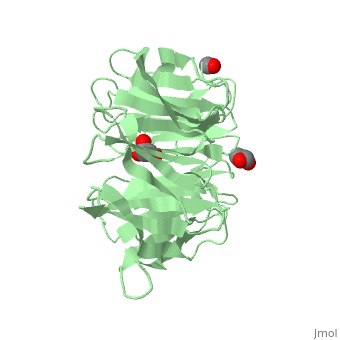Receptor for activated protein kinase C 1
FunctionReceptor for activated protein kinase C 1 (RACK1) is a scaffold protein which is able to interact simultaneously with several signaling molecules[1]. It binds to protein kinases and to membrane-bound receptors[2]. RACK1 is also part of the eukaryotic ribosome and it localizes to the small 40S subunit. RACK1 recruits activated protein kinase to the ribosome and allows translation to be linked to cellular stimuli[3]. See also Intracellular receptors RelevanceRACK1 is up-regulated in angiogenesis and human carcinomas[4]. The association of RACK1 with burial disease virus protein VP5 inhibits apoptosis and enhances viral replication[5].
|
| ||||||||||
ReferencesReferences
- ↑ Vomastek T, Iwanicki MP, Schaeffer HJ, Tarcsafalvi A, Parsons JT, Weber MJ. RACK1 targets the extracellular signal-regulated kinase/mitogen-activated protein kinase pathway to link integrin engagement with focal adhesion disassembly and cell motility. Mol Cell Biol. 2007 Dec;27(23):8296-305. Epub 2007 Oct 1. PMID:17908799 doi:http://dx.doi.org/10.1128/MCB.00598-07
- ↑ Chang BY, Conroy KB, Machleder EM, Cartwright CA. RACK1, a receptor for activated C kinase and a homolog of the beta subunit of G proteins, inhibits activity of src tyrosine kinases and growth of NIH 3T3 cells. Mol Cell Biol. 1998 Jun;18(6):3245-56. PMID:9584165
- ↑ Nilsson J, Sengupta J, Frank J, Nissen P. Regulation of eukaryotic translation by the RACK1 protein: a platform for signalling molecules on the ribosome. EMBO Rep. 2004 Dec;5(12):1137-41. PMID:15577927 doi:http://dx.doi.org/10.1038/sj.embor.7400291
- ↑ Berns H, Humar R, Hengerer B, Kiefer FN, Battegay EJ. RACK1 is up-regulated in angiogenesis and human carcinomas. FASEB J. 2000 Dec;14(15):2549-58. PMID:11099474 doi:http://dx.doi.org/10.1096/fj.99-1038com
- ↑ Lin W, Zhang Z, Xu Z, Wang B, Li X, Cao H, Wang Y, Zheng SJ. The association of receptor of activated protein kinase C 1(RACK1) with infectious bursal disease virus viral protein VP5 and voltage-dependent anion channel 2 (VDAC2) inhibits apoptosis and enhances viral replication. J Biol Chem. 2015 Mar 27;290(13):8500-10. doi: 10.1074/jbc.M114.585687. Epub 2015, Jan 12. PMID:25583988 doi:http://dx.doi.org/10.1074/jbc.M114.585687
